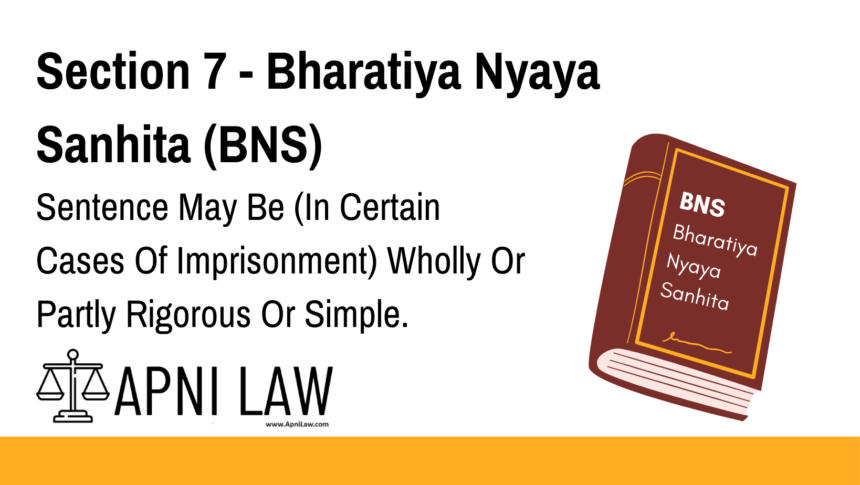Code
In every case in which an offender is punishable with imprisonment which may be of either description, it shall be competent to the Court which sentences such offender to direct in the sentence that such imprisonment shall be wholly rigorous, or that such imprisonment shall be wholly simple, or that any part of such imprisonment shall be rigorous and the rest simple.
Explanation of Section 7 BNS
Section 7 of the Bharatiya Nyaya Sanhita, 2023 (BNS) provides clarity on how a court can impose imprisonment. When a punishment includes both rigorous and simple imprisonment, the court has the discretion to decide the nature of the sentence.
Key Highlights:
- Types of Imprisonment:
- Rigorous Imprisonment: The convict is required to perform hard labor.
- Simple Imprisonment: No hard labor is involved, and the convict is only confined.
- Court’s Discretion:
- The court can fully impose rigorous imprisonment if necessary.
- It can fully impose simple imprisonment depending on the case’s severity.
- It can divide the sentence, making part of the imprisonment rigorous and the rest simple.
Legal Importance:
- This section ensures flexibility in sentencing, allowing courts to adjust punishments based on the gravity of the offense.
- It plays a crucial role in cases where the law allows judicial discretion rather than mandating a fixed punishment.
Illustrations
Example 1: A Theft Conviction
A person convicted of theft under Section 302 BNS may be sentenced to imprisonment that includes both rigorous and simple imprisonment. The judge can specify that one year of the sentence is rigorous while the remaining period is simple imprisonment.
Example 2: White-Collar Crimes
A businessman found guilty of financial fraud may receive simple imprisonment since the crime does not involve violence. However, if the fraud has severe economic implications, a court may impose rigorous imprisonment to reflect the crime’s impact.
Common Questions & Answers
1. What is the difference between rigorous and simple imprisonment?
- Rigorous Imprisonment involves hard labor, such as breaking stones or working in prison factories.
- Simple Imprisonment only confines the convict, without any hard labor.
2. Can a court decide to split imprisonment into rigorous and simple parts?
Yes, Section 7 BNS allows courts to divide the sentence so that a convict may serve part of it as rigorous imprisonment and the rest as simple imprisonment.
3. When does a court impose rigorous imprisonment?
A court imposes rigorous imprisonment when the crime involves violence, serious fraud, or habitual criminal behavior.
4. Can a convict request simple imprisonment instead of rigorous?
While a convict can appeal the sentence, the final decision rests with the court, considering the nature and severity of the offense.
5. How does Section 7 BNS impact sentencing in India?
It ensures judicial flexibility, allowing courts to impose punishment that aligns with the crime’s severity. This helps maintain fairness and proportionality in sentencing.
Conclusion
Section 7 of the BNS plays a vital role in India’s sentencing framework by granting courts the power to customize imprisonment types. This ensures justice is served appropriately while considering the nature of the offense.
For expert legal insights and case discussions, visit ApniLaw today! 🚀











